General, Sir John Monash, Personal Files Book 20, 31 July - 15 August - 1918 - Part 3
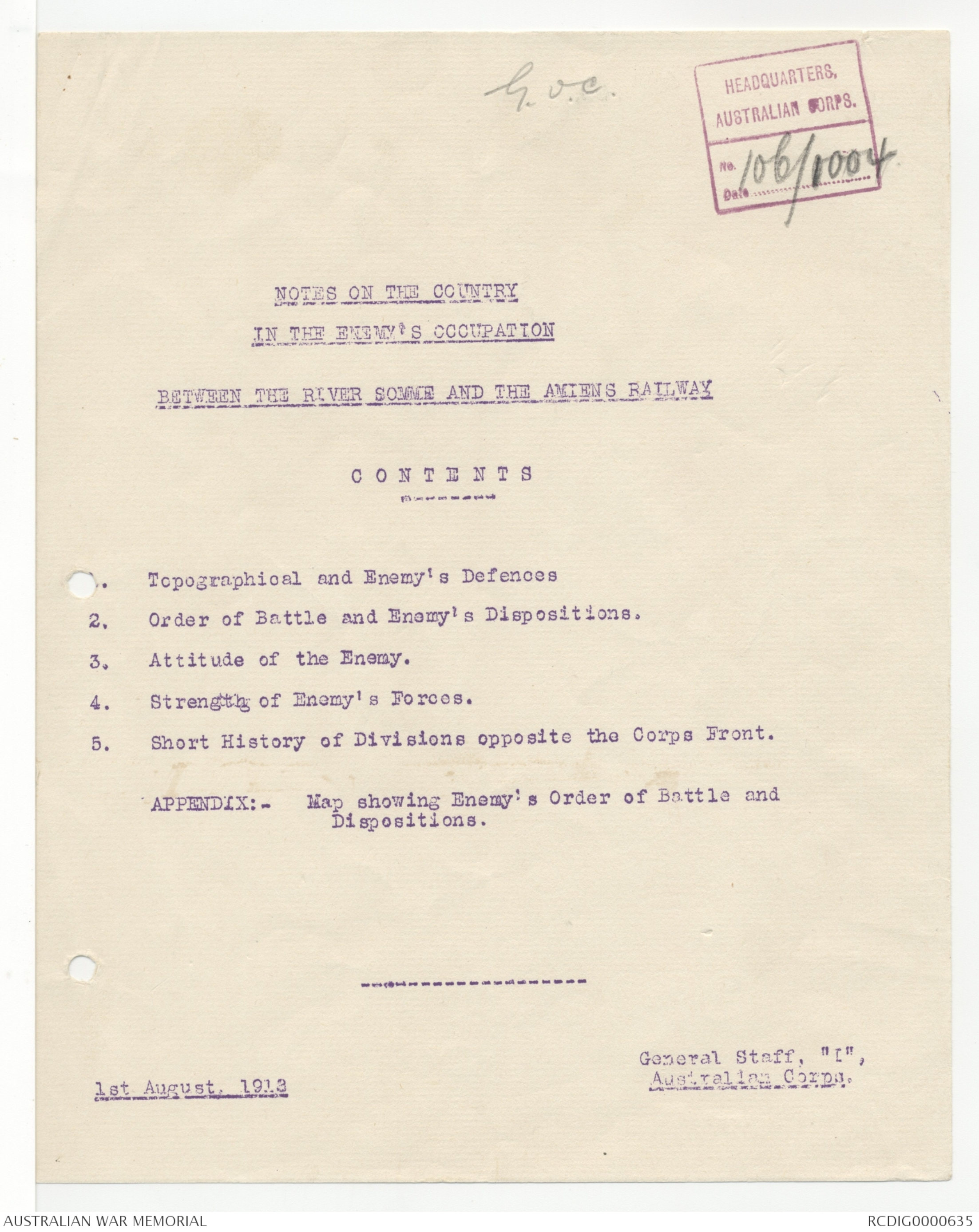
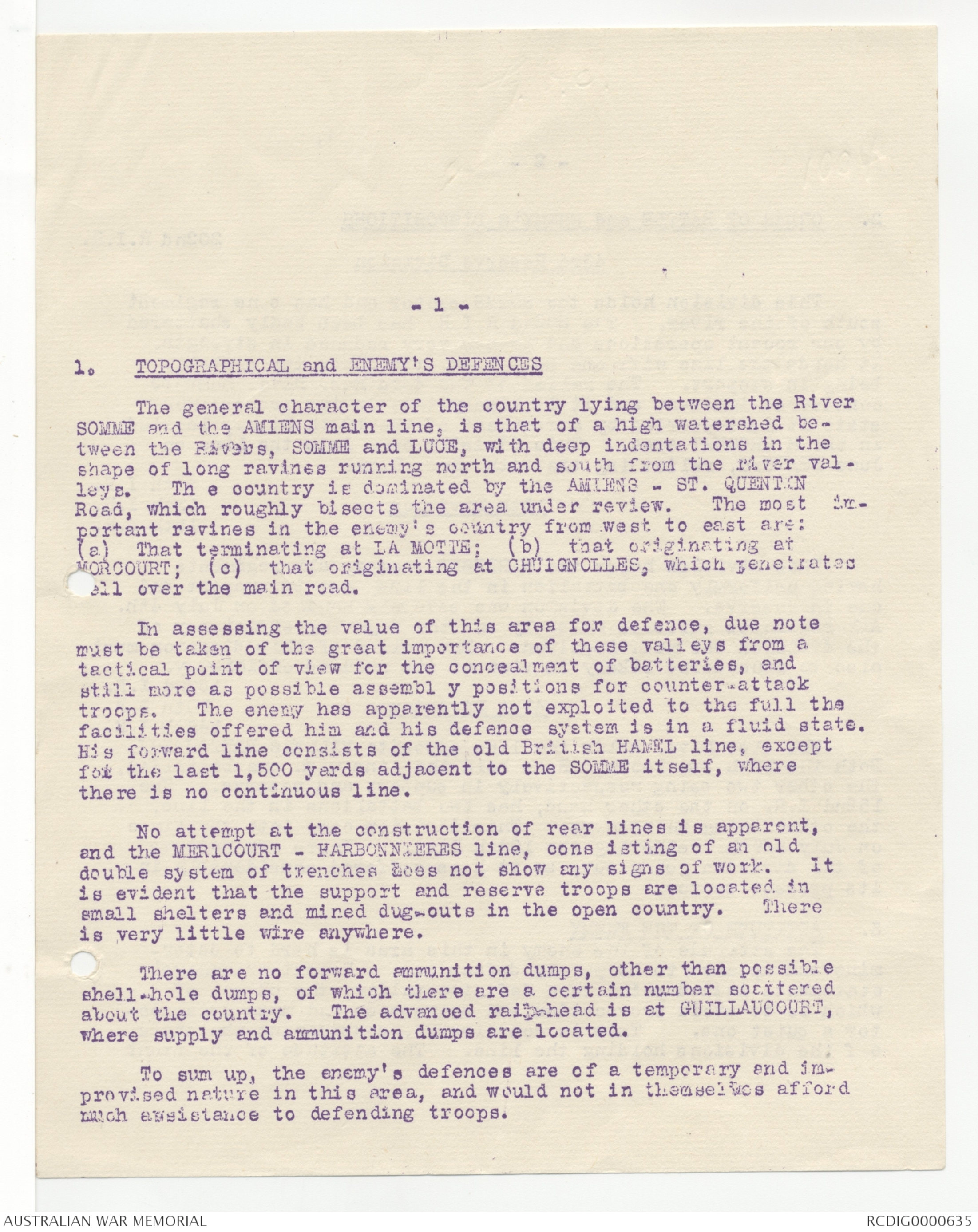
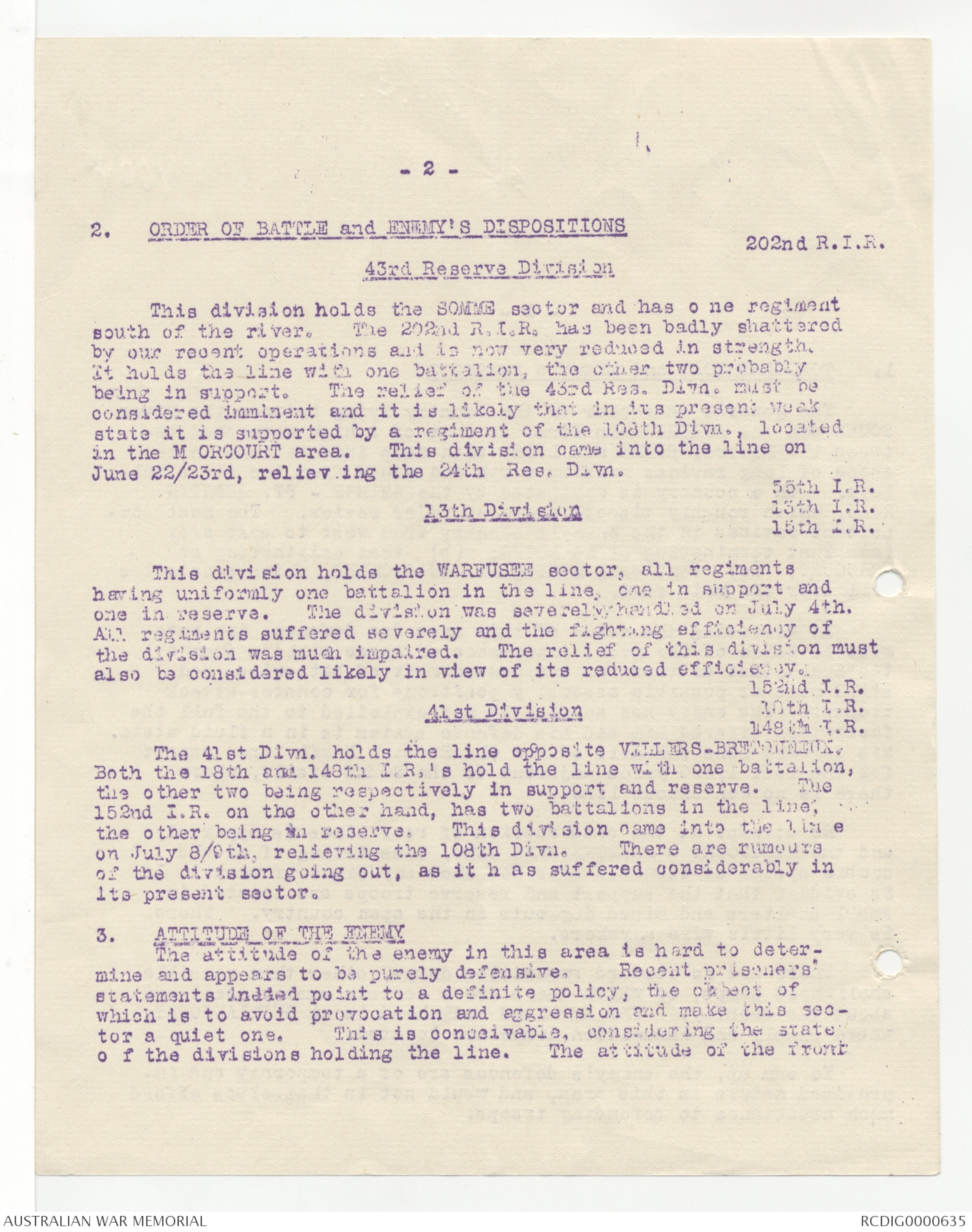
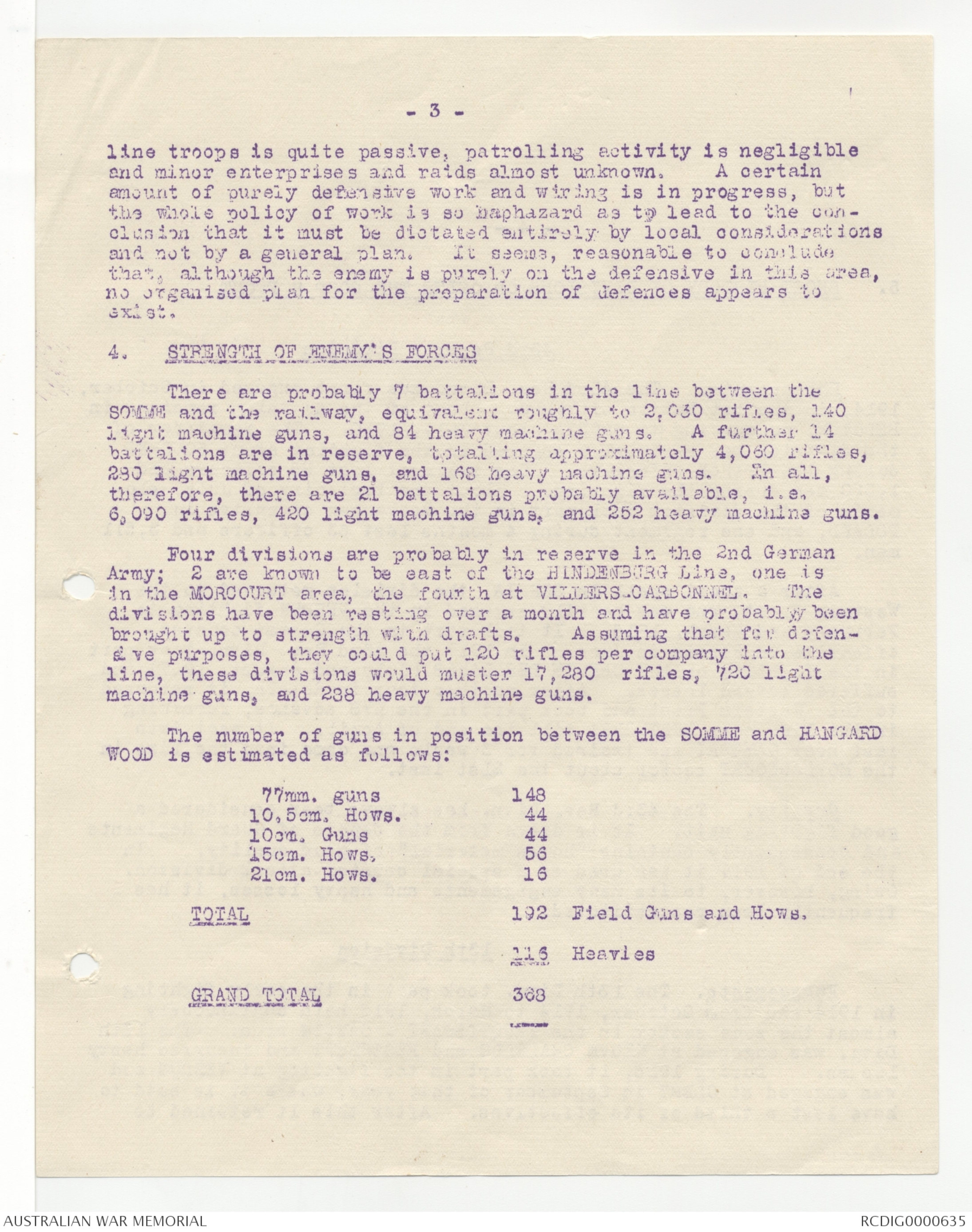
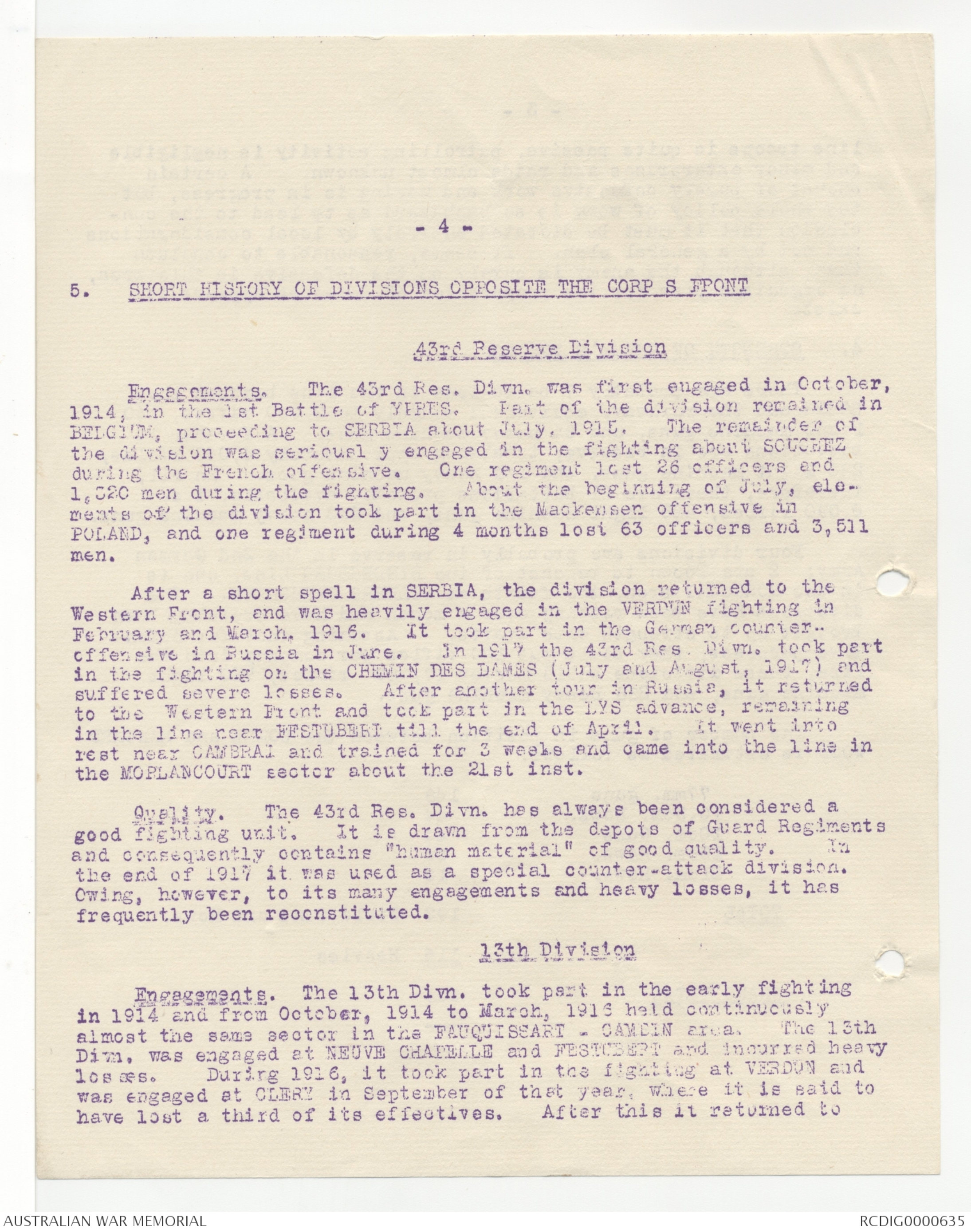
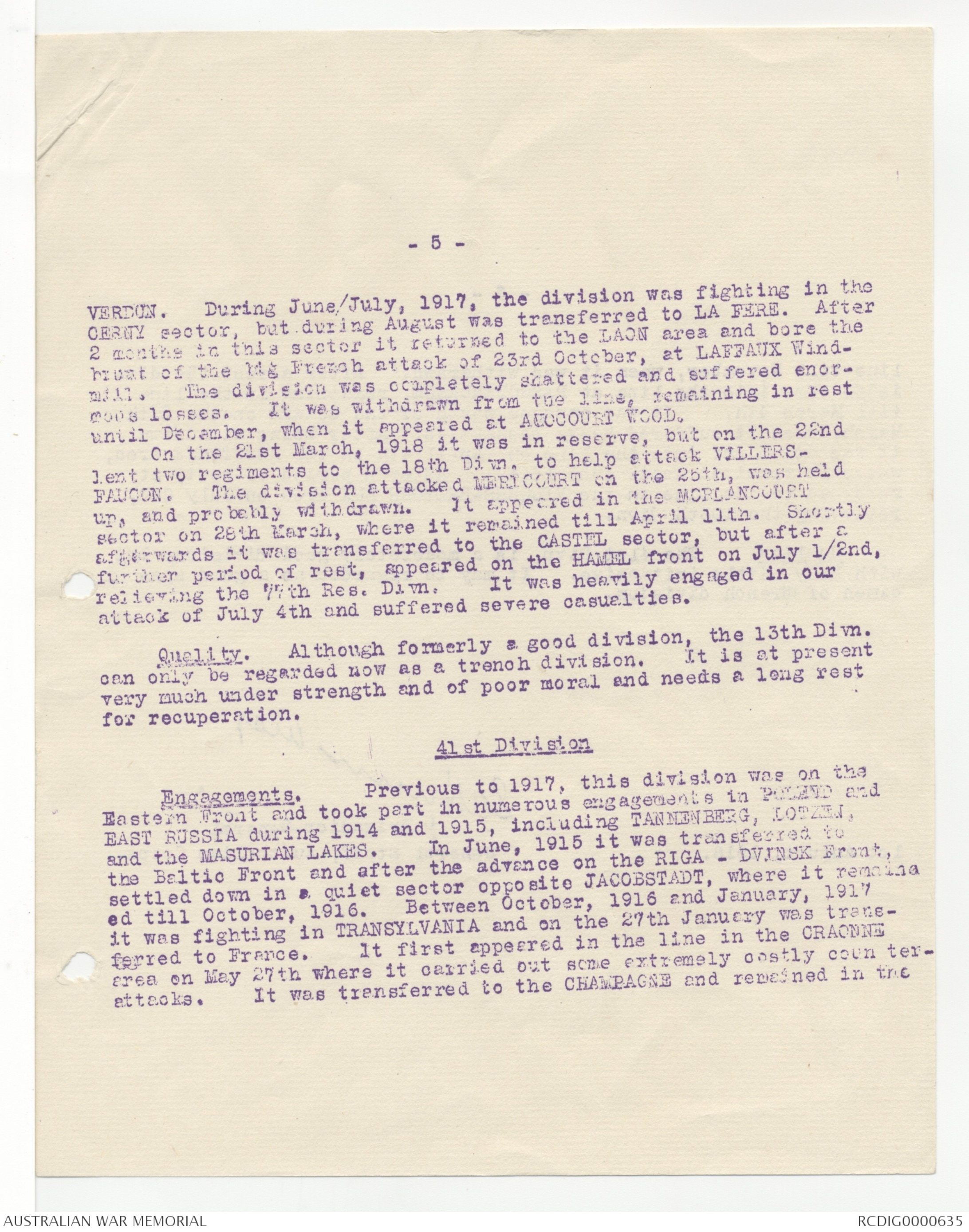
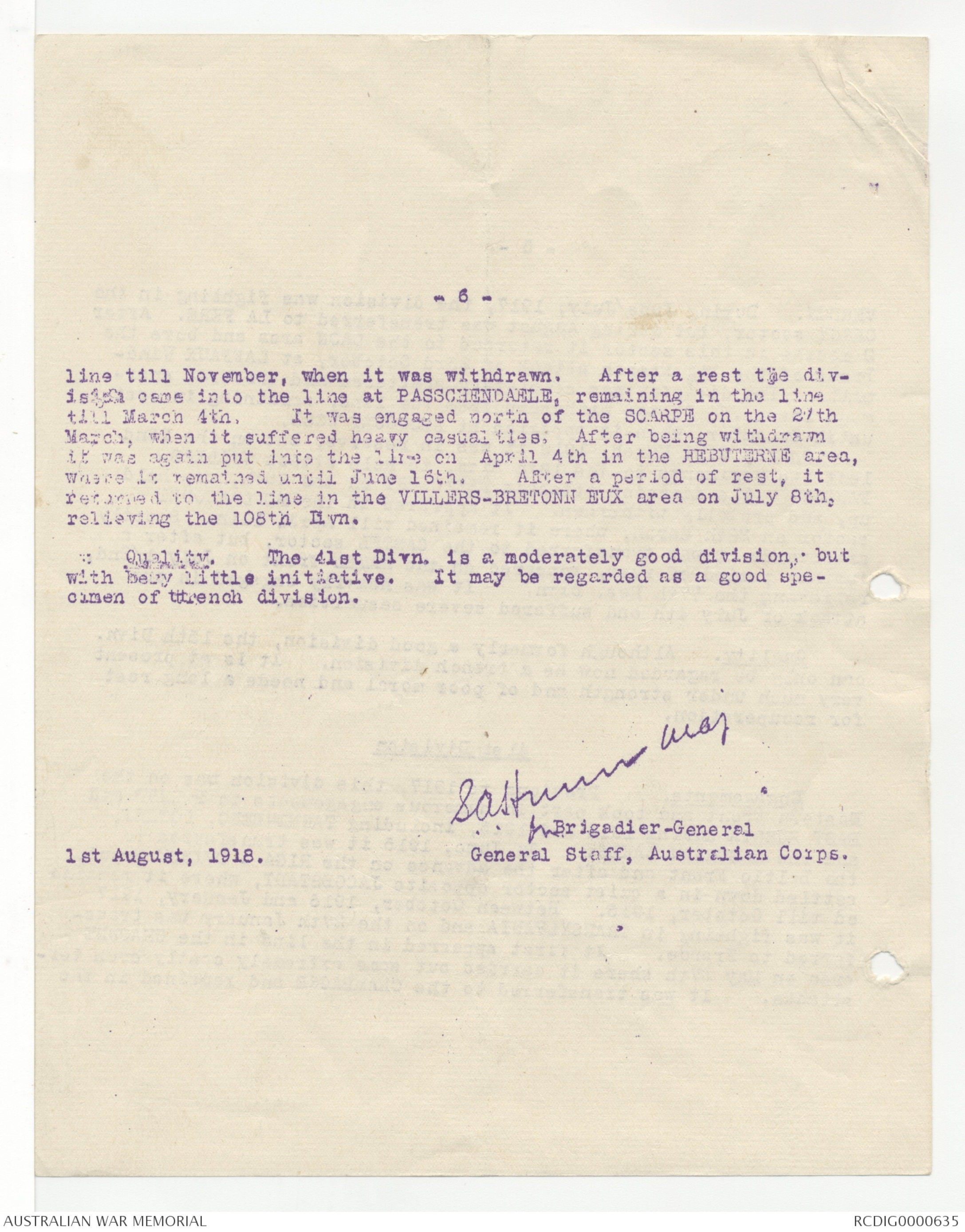
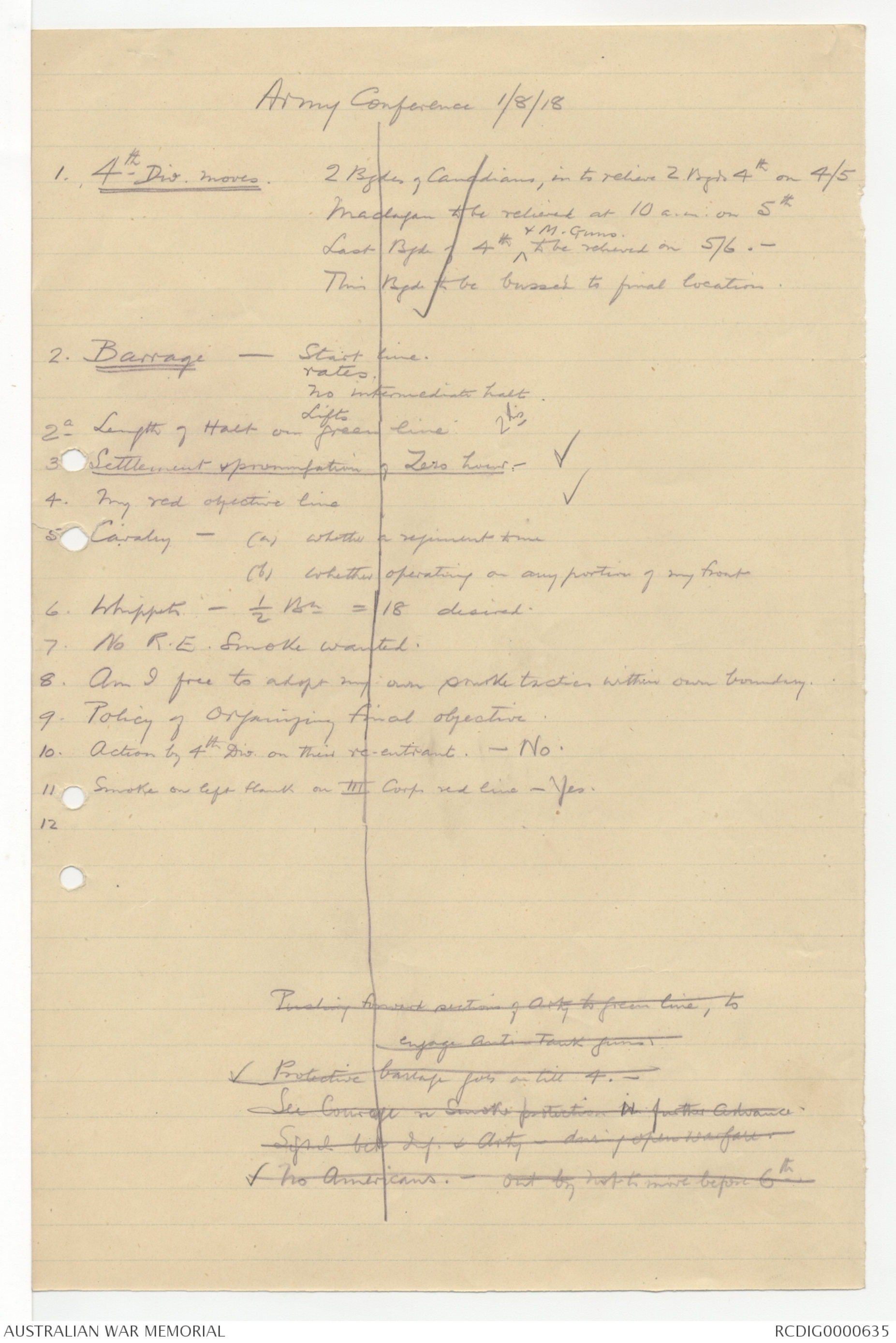
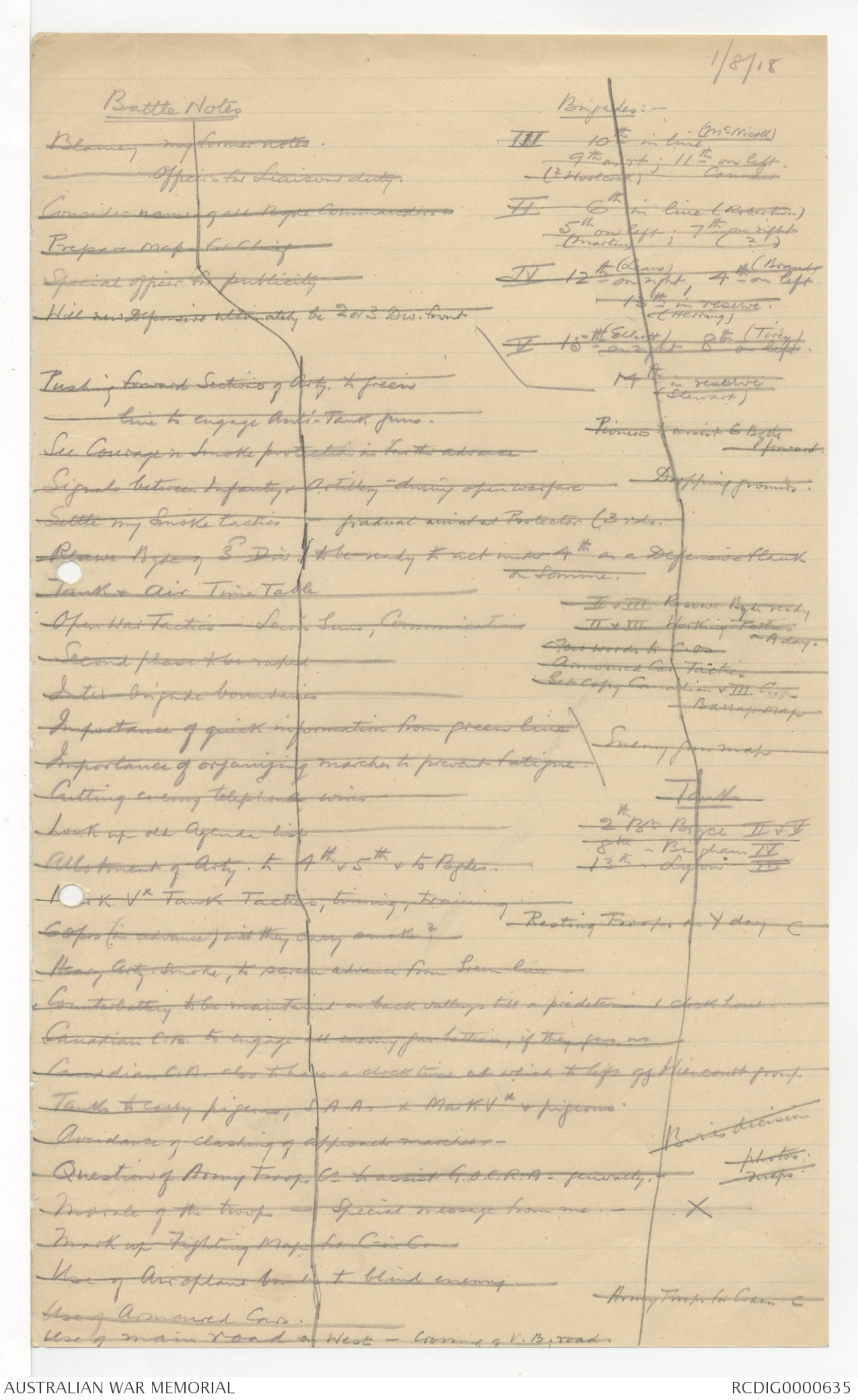
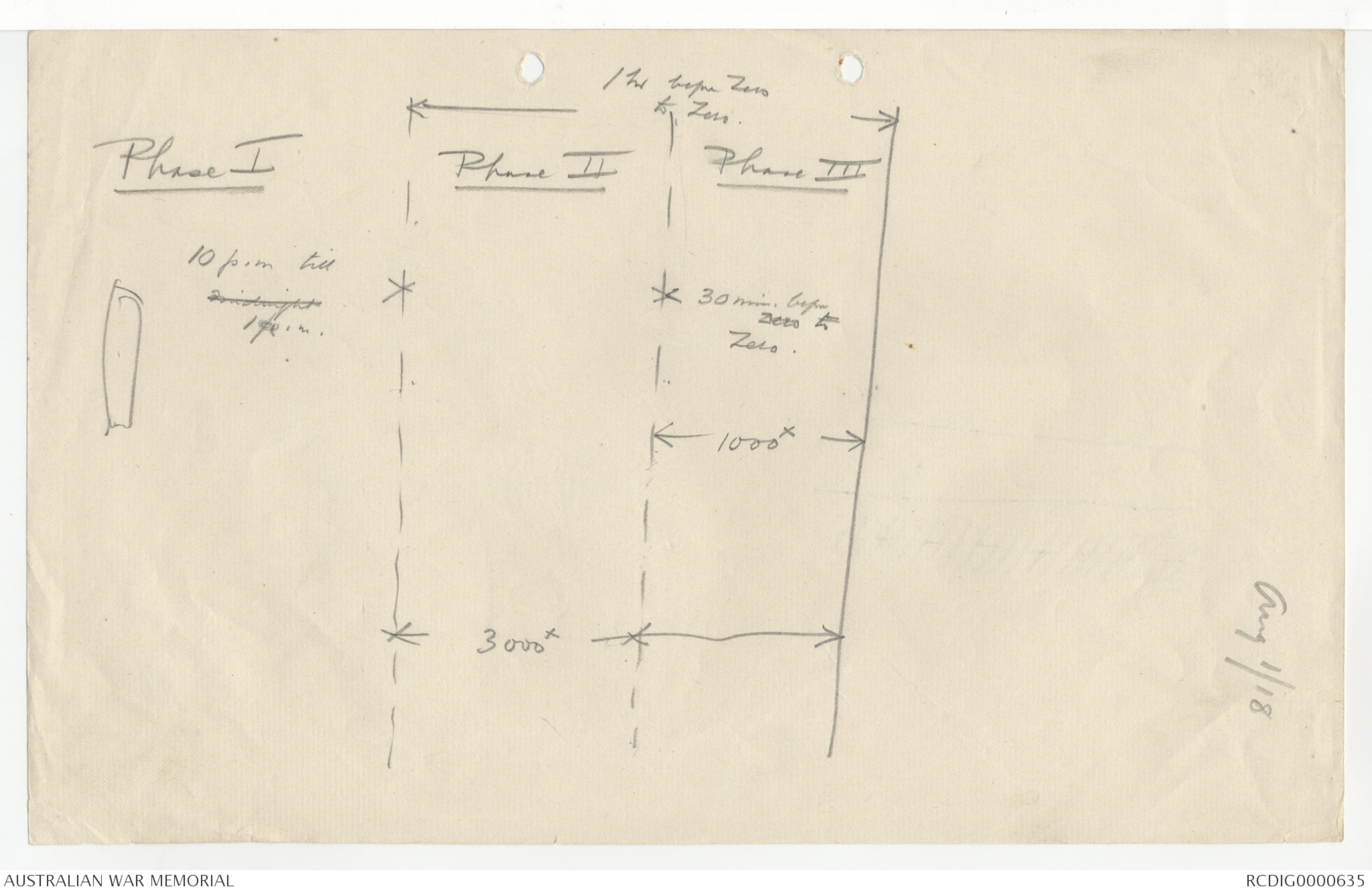
[*G.O.C.*]
[*HEADQUARTERS,
AUSTRALIAN CORPS.
No. 106/1004
Date................*]
NOTES ON THE COUNTRY
IN THE ENEMY'S OCCUPATION
BETWEEN THE RIVER SOMME AND THE AMIENS RAILWAY
CONTENTS
1. Topographical and Enemy's Defences
2. Order of Battle and Enemy's Dispositions.
3. Attitude of the Enemy.
4. Strength of Enemy's Forces.
5. Short History of Divisions opposite the Corps Front.
APPENDIX:- Map showing Enemy's Order of Battle and
Dispositions.
General Staff. "I"
Australian Corps
1st August, 1918
- 1 -
1. TOPOGRAPHICAL and ENEMY'S DEFENCES
The general character of the country lying between the River
SOMME and the AMIENS main line, is that of a high watershed between
the Rivers, SOMME and LUCE, with deep indentations in the
shape of long ravines running north and south from the river valleys.
The country is dominated by the AMIENS - ST. QUENTON
Road, which roughly bisects the area under review. The most important
ravines in the enemy's country from west to east are:
(a) That terminating at LA MOTTE; (b) that originating at
MORCOURT; (c) that originating at CHUIGNOLLES, which penetrates
well over the main road.
In assessing the value of this area for defence, due note
must be taken of the great importance of these valleys from a
tactical point of view for the concealment of batteries, and
still more as possible assembly positions for counter-attack
troops. The enemy has apparently not exploited to the full the
facilities offered him and his defence system is in a fluid state.
His forward line consists of the old British HAMEL line, except
for the last 1,500 yards adjacent to the SOMME itself, where
there is no continuous line.
No attempt at the construction of rear lines is apparent,
and the MERICOURT - HARBONNIERES line, cons isting of an old
double system of trenches does not show any signs of work. It
is evident that the support and reserve troops are located in
small shelters and mined dug-outs in the open country. There
is very little wire anywhere.
There are no forward ammunition dumps, other than possible
shell-hole dumps, of which there are a certain number scattered
about the country. The advanced rail-head is at GUILLAUCOURT,
where supply and ammunition dumps are located.
To sum up, the enemy's defences are of a temporary and improvised
nature in this area, and would not in themselves afford
much assistance to defending troops.
- 2 -
2. ORDER OF BATTLE and ENEMY'S DISPOSITIONS
202nd R.I.R.
43rd Reserve Division
This division holds the SOMME sector and has one regiment
south of the river. The 202nd R.I.R. has been badly shattered
by our recent operations and is now very reduced in strength.
It holds the line with one battalion, the other two probably
being in support. The relief of the 43rd Res. Divn. must be
considered imminent and it is likely that in its present weak
state it is supported by a regiment of the 108th Div., located
in the MORCOURT area. This division came into the line on
June 22/23rd, relieving the 24th Res. Divn.
55th I.R.
13th Division 13th I.R.
15th I.R
This division holds the WARFUSEE sector, all regiments
having uniformly one battalion in the line, one in support and
one in reserve. The division was severely handled on July 4th.
All regiments suffered severely and the fighting efficiency of
the division was much impaired. The relief of this division must
also be considered likely in view of its reduced efficiency.
152nd I.R.
41st Division 18th I.R.
148th I.R.
The 4lst Divn. holds the line opposite VILLERS-BRETONNEUX.
Both the 18th and 148th I.R.'s hold the line with one battalion,
the other two being respectively in support and reserve. The
152nd I.R. on the other hand, has two battalions in the line;
the other being reserve. This division came into the line
on July 8/9th, relieving the 108th Divn. There are rumours
of the division going out, as it h as suffered considerably in
Its present sector.
3. ATTITUDE OF THE ENEMY
The attitude of the enemy in this area is hard to determine
and appears to be purely defensive, Recent prisoners'
statements indeed point to a definite policy, the object of
which is to avoid provocation and aggression and make this sector
a quiet one. This is conceivable, considering the state
o f the divisions holding the line. The attitude of the front
- 3 -
line troops is quite passive, patrolling activity is negligible
and minor enterprises and raids almost unknown. A certain
amount of purely defensive work and wiring is in progress, but
the whole policy of work is so haphazard as to lead to the conclusion
that it must be dictated entirely by local considerations
and not by a general plan. It seems, reasonable to conclude
that, although the enemy is purely on the defensive in this area,
no organised plan for the preparation of defences appears to
exist.
4. STRENGTH OF ENEMY'S FORCES
There are probably 7 battalions in the line between the
SOMME and the railway, equivalent roughly to 2,030 rifles, 140
light machine guns, and 84 heavy machine guns. A further 14
battalions are in reserve, totalling approximately 4,060 rifles,
280 light machine guns, and 168 heavy machine guns. In all,
therefore, there are 21 battalions probably available, i.e.
6,090 rifles, 420 light machine guns, and 252 heavy machine guns.
Four divisions are probably in reserve in the 2nd German
Army; 2 are known to be east of the HINDENBURG Line, one is
in the MORCOURT area, the fourth at VILLERS-CARBONNEL. The
divisions have been resting over a month and have probably been
brought up to strength with drafts. Assuming that for defensive
purposes, they could put 120 rifles per company into the
line, these divisions would muster 17,280 rifles, 720 light
machine guns, and 288 heavy machine guns.
The number of guns in position between the SOME and HANGARD
WOOD is estimated as follows:
77mm. guns 148
10.5cm. Hows. 44
10cm. Guns 44
15cm. Hows. 55
21cm. Hows. 16
TOTAL 192 Field Guns and Hows.
116 Heavies
GRAND TOTAL 308
- 4 -
5. SHORT HISTORY OF DIVISIONS OPPOSITE THE CORP S FRONT
43rd Reserve Division.
Engagements. The 43rd Res. Divn. was engaged in October,
1914, in the 1st Battle of YPRES. Part of the division remained in
BELGIUM, proceeding to SERBIA about July 1915. The remainder of
the division was seriousl y engaged in the fighting about SOUCHEZ
during the French offensive. One regiment lost 26 officers and
1,320 men during the fighting. About the beginning of July, elements
of the division took part in the Mackensen offensive in
POLAND, and one regiment during 4 months lost 63 officers and 3,511
men.
After a short spell in SERBIA, the division returned to the
Western Front, and was heavily engaged in the VERDUN fighting in
February and March, 1916 .It took part in the German counter-offensive
in Russia in June. In 1917 the 43rd Res. Divn. took part
in the fighting on the CHEMIN DES DAMES (July and August, 1917) and
suffered severe losses. After another tour in Russia, it returned
to the Western Front and took part in the LYS advance, remaining
in the line near FESTUBERT till the end of April. It went into
rest near CAMBRAI and trained for 3 weeks and came into the line in
the MORLANCOURT sector about the 21st inst.
Quality. The 43rd Res. Divn. has always been considered a
good fighting unit. It is drawn from the depots of Guard Regiments
and consequently contains "human material" of good quality. In
the end of 1917 it was used as a special counter-attack division.
Owing, however, to its many engagements and heavy losses, it has
frequently been reconstituted.
13th Division
Engagements. The 13th Divn. took part in the early fighting
in 1914 and from October, 1914 to March, 1916 held continuously
almost the same sector in the FAUQUISSART - CAMSIN area. The 13th
Divn, was engaged at NEUVE CHAPELLE and FESTUSEPT and incurred heavy
losses. During 1916, it took part in the fighting at VERDUN and
was engaged at CLERY in September of that year, where it is said to
have lost a third of its effectives. After this it returned to
- 5 -
VERDUN. During June/July, 1917, the division was fighting in the
CERNY sector, but during August was transferred to LA FERE. After
2 months in this sector it returned to the LAON area and bore the
brunt of the big French attack of 23d October, at LAFFAUX Windmill.
The division was completely shattered and suffered enormous
losses. It was withdrawn from the line, remaining in rest
until December, when it appeared at AVOCOURT WOOD.
On the 21st March, 1918 it was in reserve, but on the 22nd
lent two regiments to the 18th Divn, to help attack VILLERS-FAUCON.
The division attacked MERICOURT on the 25th, was held
up, and probably withdrawn. It appeared in the MORLANCOURT
sector on 28th March, where it remained till April 11th. Shortly
afterwards it was transferred to the CASTEL sector, but after a
further period of rest, appeared on the HAMEL front on July 1/2nd,
relieving the 77th Res. Divn. It was heavily engaged in our
attack of July 4th and suffered severe casualties.
Quality. Although formerly a good division, the 13th Divn.
can only be regarded now as a trench division. It is at present
very much under strength and of poor moral and needs a long rest
for recuperation.
4lst Division
Engagements. Previous to 1917, this division was on the
Eastern Front and took part in numerous engagements in POLAND and
EAST RUSSIA during 1914 and 1915, including TANNENBERG, LOTZEN,
and the MASURIAN LAKES. In June, 1915 it was transferred to
the Baltic Front and after the advance on the RIGA - DVINSK Front,
settled down in a quiet sector opposite JACOBSTADT, where it remained
till October, 1916. Between October, 1916 and January, 1917
it was fighting in TRANSYLVANIA and on the 27th January was transferred
to France. It first appeared in the line in the CRAONNE
area on May 27th where it carried out some extremely costly coun ter-attacks.
It was transferred to the CHAMPAGNE and remained in the
- 6 -
line till November, when it was withdrawn. After a rest the division
came into the line at PASSCHENDAELE, remaining in the line
till March 4th. It was engaged north of the SCARPE on the 27th
March, when it suffered heavy casualties: After being withdrawn
it was again put into the line April 4th in the HEBUTERNE area,
where it remained until June 16th. After a period of rest, it
returned to the line in the VILLERS-BRETONNEUX area on July 8th,
relieving the 108th Divn.
QUALITY
The 41st Divn. is a moderately good division, but
with very little initiative. It may be regarded as a good specimen
of trench division.
S. A. Hummer Maj
per Brigadier-General
General Staff, Australian Corps.
1st August, 1918.
Army Conference 1/8/18
- 4th Div. moves. 2 Bgdes of Canadians, in to relieve 2 Bgdes 4th on 4/5
MacLagan to be relieved at 10 a.m. on 5th
Last Bgde of 4th ^M.Guns to be relieved on 5/6.-
This Bgde to be bussed to final location
√
2. Barrage – Start line.
rates.
No intermediate halt.
Lifts
2a Length of halt on present line 2 hrs
3 Settlement & promalgation of Zero hour.- √
4. My red objective line √
5 Cavalry – (a) whether a regiment to use
(b) whether operating on any portion of my front
6. Whippets – ½Bn = 18 desired.
7. No R.E. Smoke wanted.
8. AM I free to adapt my own smoke tactics within our boundary.
9. Policy of organizing final objective.
10. Action by 4th Div. on their re-entrant. – No.
11 Smoke on left flank on III Corps red line – Yes.
12Pushing forward sections of Arty to front line, toengage anti-tank guns.√ Protective barrage goes on till 4.-See Counter or Smoke protection in further advance.S[[?]] [[?]] Inf. & Arty - during open warfare &√ No Americans. - out bn not to move before 6th
1/8/18
Battle NotesBlamey - my former notes.Officer for liaison duty.Consider naming all Bgde CommandersPrepare map for ChiefSpecial officer for publicityWill new Defensive [[?]]inately be 2 or 3 Div. frontPush forward Sections of Arty. to greenline to engage Anti-Tank guns.See Counter & Smoke protection in for the advanceSignals between Infantry & Artillery - during open warfareSettle my Smike tactics - gradual ??? at P[[?]] (3 rds.Reserve Bgde of 3rd Div. to be ready to act with 4th on a Defensive flankon Somme.Tank & Air Time TableOpen War Tactics - Lewis Guns, CommunicationsSecond phase to be ropedIntel on ???? boundariesImportance of quick information from green lineImportance of organizing marches to prevent fatigueCutting enemy telephone wireLook up all agenda listsAllotment of Arty. to 4th & 5th & to Bdges.Nos K. Vx Tank Tactics, timing, trainingResting Troops on Y day C60 prs (in advance) will they carry smoke? Heavy Arty Smoke, to screen advance from green lineCounter battery to be maintained on back valleys till a predetermined clock handCanadian C.B. to engage all enemy gun batteries, if they [[?]] noCanadian C.A. also to have a clock time at which to lift off their [[?]] [[?]]Tanks to carry pigeons, S.A.A. x MarkKVx & pigeons.Avoidance of clashing of approved marches & -Question of Army Troop Co to assist G.O.C.R.A. - generally. -Morale of the troops - Special message from me.-Mark up Fighting Map for C-in-C.Use of aeroplane bombs to blind emery .-
Use of Armoured Cars.Use of main road on West - Crossing of V.B. road.
Brigades:-III 10th in line (McNicoll)9th on rt; 11th on left.(? [[?]]) Can[[?]]II 6th in line (5th on left; 7th on right
(Martin) (?)IV (Leane) (Br[[?]])12th on right, 4th on left13th in reserve.(Herring)V 15th (Elliott) 8th (Tivey)on right on left.14th in reserve(Stewart)Pioneers to assist 6 Bgdesforward.Dropping grounds.II & III Reserve Bgdes readyII & III Working Partieson A day.Few words to C.OsArmoured Car TacticsS[[?]] copy Canadian & III CorpBatt[[?]] MapEnemy from mapTanks2th Bn Bryce II & V8th " Bringham IV13th " Lyon IIIB[[?]] decision photos.maps.XArmy Troops for C[[?]] C
Diagram - see original document
 Lilly
LillyThis transcription item is now locked to you for editing. To release the lock either Save your changes or Cancel.
This lock will be automatically released after 60 minutes of inactivity.